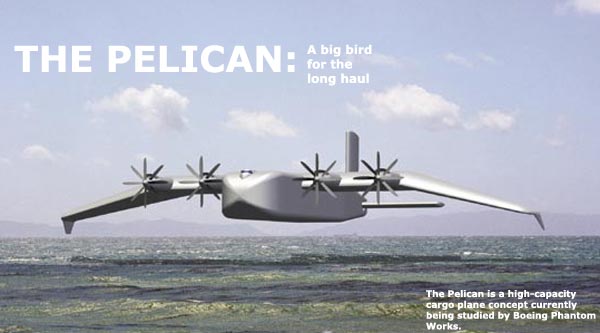|
||||||||
| Phantom Works |
 BY WILLIAM COLE It would be the biggest bird in the history of aviation. Dwarfing all previous flying giants, the Pelican, a high-capacity cargo plane concept currently being studied by Boeing Phantom Works, would stretch more than the length of a U.S. football field and have a wingspan of 500 feet and a wing area of more than an acre. It would have almost twice the external dimensions of the world's current largest aircraft, the Russian An225, and could transport five times its payload, up to 1,400 tons of cargo. Designed primarily for long-range, transoceanic transport, the Pelican would fly as low as 20 feet above the sea, taking advantage of an aerodynamic phenomenon that reduces drag and fuel burn. Over land, it would fly at altitudes of 20,000 feet or higher. Operating only from ordinary paved runways, the Pelican would use 38 fuselage-mounted landing gears with a total of 76 tires to distribute its weight. The military, commercial and even space prospects for such a cargo plane—officially known as the Pelican Ultra Large Transport Aircraft, or ULTRA—are also huge. "The Pelican can broaden the range of missions for which airplanes are the favored way to deliver cargo," said Boeing's Pelican program manager Blaine Rawdon, who is designing the plane with Boeing engineer Zachary Hoisington. "It is much faster than ships at a fraction of the operational cost of current airplanes. This will be attractive to commercial and military operators who desire speed, worldwide range and high throughput. We envision that the Pelican can multiply aircraft's 1-percent share in a commercial market now dominated by container ships." John Skorupa, senior manager of strategic development for Boeing Advanced Airlift and Tankers, said, "The Pelican currently stands as the only identified means by which the U.S. Army can achieve its deployment transformation goals of deploying one division in five days, or five divisions in 30 days, anywhere in the world." If necessary, he said, the Pelican could carry 17 M-1 main battle tanks on a single sortie. Commercially, the aircraft's size and efficiency would allow it to carry types of cargo equivalent to those carried by container ships, at more than 10 times the speed. "It is attracting interest as a mother ship for unmanned vehicles, enabling rapid deployment of a network-centric warfare grid, a likely future mode of operation for modernized U.S. forces as demonstrated in Afghanistan," Skorupa said. "And it is attracting interest as a potential first-stage platform for piggybacking reusable space vehicles to an appropriate launch altitude. "Why would such a huge airplane be flown at such a low altitude? By flying low, the Pelican, like its name-sake, exploits the aerodynamic benefits of a well-known phenomenon called ground effect. Flying close to water, the wing downwash angle and tip vortices are suppressed, resulting in a major drag reduction and outstanding cruise efficiency. "It's an effect that provides extraordinary range and efficiency," Skorupa said. "With a payload of 1.5 million pounds, the Pelican could fly 10,000 nautical miles over water and 6,500 nautical miles over land. "Flying in ground effect demands the latest flight control technology, conceded Skorupa. Reliable systems will provide precise, automatic altitude control and collision avoidance. Cruise altitude will be adjusted according to sea state, and if the seas get too rough, the Pelican can easily climb to high altitude to continue the flight. When could the Pelican be flying? The answer may lie in the Army's Advanced Mobility Concepts Study, scheduled for release next April. The Pelican has been offered by Boeing as part of a system-of-systems solution that would include the C-17 Globemaster III transport, the CH-47 Chinook helicopter and the Advanced Theater Transport. "A favorable report would set the stage for a possible codevelopment effort between Boeing, the U.S. military and interested commercial cargo carriers," Skorupa said. |
| Contact Us | Site Map| Site Terms | Privacy | Copyright | ||||||
| © 2002 The Boeing Company. All rights reserved. |